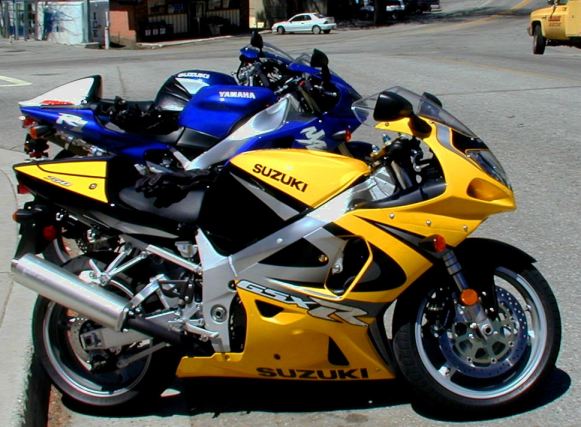
With great anticipation, I took delivery of Suzuki’s 2000 GSX-R750 late last week. As you know, from my extensive review of this bike’s design and technical specifications (December 20, 1999 and December 21, 1999), I have been waiting for a chance to ride this motorcycle for quite a long time.
This last weekend, I took two extensive rides on the new GSXR — one on Saturday, and one on Sunday. On Saturday, I took a solo trip to the top of Mt. Palomar here in Southern California (and back down, of course). After a long cruise through mildly twisting country roads, you climb Mt. Palomar on a pristine, newly paved, tight series of bends and switchbacks.
On Sunday, I rode with my friend Jeff Whitmer, and his frequent riding buddy, Dylan, up to another mountain resort area (this one called Idyllwild). We then descended the backside of the mountain together, and proceeded on freeway and highway home.
The 2000 GSX-R750 dramatically exceeded my expectations. First and foremost, the motor is simply incredible. It has so much more power and torque than a 750cc motor has a right to have that you wonder just how inefficient the other manufacturers are with their engine designs. You may have seen dyno figures for the GSX-R750 elsewhere. Reports put rear wheel horsepower at roughly 126. This puts the 750cc motor in the thick of the open class — neck-and-neck with Honda’s CBR929RR (which has seen lower horsepower figures in some of the published dyno runs), Kawasaki’s ZX-9R (a few horsepower higher) and Yamaha’s R1 (also just a few horsepower higher).
But peak horsepower isn’t the whole story. In fact, it’s probably the less important story. The mid-range pull from the new GSXR is even more impressive. At just 4,000 rpm, the GSXR is remarkably strong. It builds progressively from there into a mad, horsepower-crazed rush above 9,000 rpm to roughly 14,000 rpm.
Back to the mid-range — think of it as a 600 on steroids. Kawasaki’s ZX6R and Honda’s CBR600F4 pull you around town quite well from 4,000 rpm. The GSX-R750 pulls much, much harder from 4,000 rpm. It is more than adequately fast between 4,000 and 8,000 rpm — really all you need without being in “full race mode”.
The fact that the power steps up dramatically at 9,000 rpm, tells you just how strong the GSXR is up top. Jeff rides a 1998 Yamaha R1 with a slip on exhaust. His R1 is plenty quick, and representative of any other standard R1 (he’s ridden the 2000, and it’s no quicker than his bike, for instance). I tried rolling on the throttle with Jeff at my side on two occasions. I told Jeff I would take the GSXR to its “sweet spot”, i.e., 9,000 rpm, and cruise next to him for a few seconds. I would then snap the throttle open and he would just as quickly snap his throttle open and we would see what transpired. Both times, the GSXR pulled away from the R1. I need to explain a couple of things, however.
First of all, the GSXR was in third gear at 9,000 rpm. It turns out that the R1 was somewhat “between gears” at this speed. We did this exercise twice, once with Jeff in second gear at 10,000 rpm (slightly above the R1’s power peak), and once with Jeff in third gear at roughly 6,500 rpm (slightly below the R1’s power peak — but a fairly sweet spot for the R1 to begin accelerating). Nevertheless, on the second occasion, as Jeff accelerated from 6,500 rpm on his R1, he really wasn’t catching me on the GSX-R750. We had to roll off the throttle after a few hundred yards, in this instance.
This is the first installment in my reports on the GSX-R750. I’ll talk to you more about handling next time. The motor’s performance is simply stunning — and this is my strongest first impression of the bike. It’s not going to have quite the low rpm and mid-range thrust of an R1, but it’s surprisingly strong down low, and the top end rush is right there with the open classers. Remarkable for 750cc.





